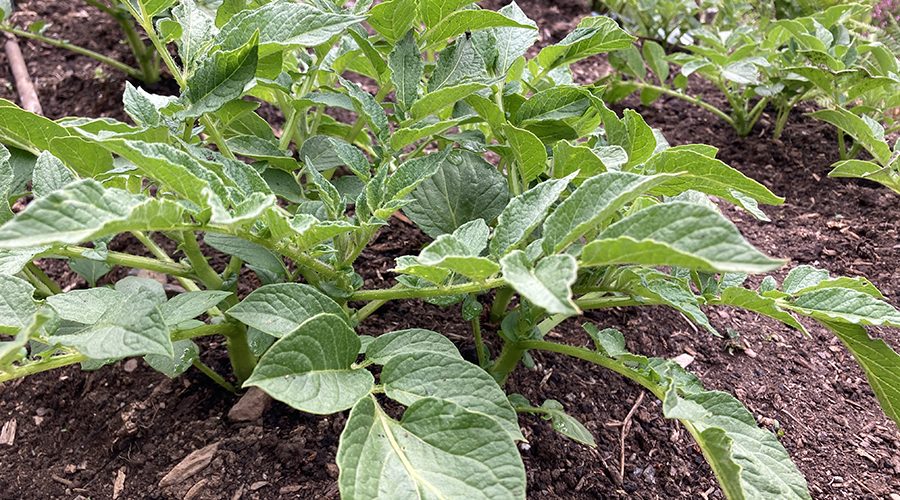Some ‘earlies’ may be ready for harvesting in the next week or so, other ‘maincrops’ can stay in the ground for a couple more months. Here’s a guide to growing, harvesting and storing your potatoes over the next few months.
Looking after potato plants:
- You can stop earthing up potatoes in late May/June, as all risk of frost has passed by this time.
- Water potatoes thoroughly 2 times a week during very hot, dry spells – this will give the plants a good amount of water that sinks deep into the soil, whilst allowing the top 2-3cm of soil to dry out in between waterings which will help to keep blight at bay.
- Keep an eye out for signs of blight (see below)
- Try to keep potato plants free from weeds
Problems & Pests:
- Blight – Check your potato plants regularly for brown patches on the leaves. This is the first sign that they have blight, a fungal spore-driven disease. If it’s more advanced, you may see brown patches on the stems as well, and the leaves will have started to rot. Remove affected foliage and get rid of it (burning it is best). Then, try removing a few more of the leaves to allow air to circulate better between plants. Keep an eye on things and with any luck you may have got it under control before it got too bad! If the crop is badly affected, cut off all the foliage at the base of the stems. You can leave the potato tubers in the ground for two weeks to let the potato skins harden and then dig them up.
- Slugs – potatoes are often affected by slug damage that happens underground where we cannot see it, even though the foliage looks beautifully healthy. If you do have a lot of slugs in your garden it is worth protecting potatoes with beer traps etc, and try to let the soil dry out between waterings.
- Scab – This bacteria-driven disease causes “scabby” rough patches on the skin of potato tubers and often occurs in hot, dry summers. It can be avoided by watering regularly and thoroughly. It’s not a major problem and you can scrape or peel the tubers before cooking to enjoy your crop anyway.
- Potatoes fall apart when cooked – this is a sign that they have not had enough water during the growing season.
Harvesting/Storing:
- Earlies – normally new potatoes, this is the group of potatoes that reach maturity fastest, usually 10-12 weeks. They are ready to harvest when the flowers open. If planted in late April/May, First Earlies are usually ready for harvesting in early/mid July and Second Earlies in mid July/August. They’ll happily sit in the ground for 3-4 weeks after that if you cut the foliage off. They should be cooked as soon as possible after being harvested.
- Maincrop – these are bigger potatoes that are generally of the floury texture – good for roasting, mashing & baking. They are ready to harvest once the foliage starts to turn yellow towards the end of the season, in September/October. You can harvest them or cut the foliage back and leave in the ground for several weeks (not advisable if it’s damp and there are lots of slugs in your garden though.) They take around 20 weeks to grow and once harvested can be stored in a hessian sack in a cool, dark place over the winter.
You don’t need to harvest them all at once…
If you cut off the foliage, your potatoes will stop growing and will keep in the ground for up to a month (for earlies) or two months (main crop – providing it’s not frosty at the time you harvest them).
The only risk with this is a few bugs eating away at them – wire worm and slugs are the most likely offenders. If you’re worried about this, you can harvest them and put them into a hessian sack.
How to Store Potatoes
Ideally, store potatoes in a hessian sack, unwashed. Keep them in a cool, dry, dark and airy place and they’ll keep well for a month or so.
Following On With Other Plants
Once you’ve harvested potatoes, you can plant up again straight away. Usually the soil is nice and loose, and this makes it great for planting up some leek seedlings which will grow into autumn and give you a good crop to enjoy over the colder months. Alternatively, firm the soil back down again and plant up a whole host of brassicas – kale, cabbages, cauliflower etc, to keep you going. They will do well from being planted in July, after harvesting Earlies, and should be harvestable around Christmas time, and there’s another chance to plant brassicas and winter leaves in September/October after you harvest maincrops.

